Marco Minici
The Urban Impact of AI: Modeling Feedback Loops in Next-Venue Recommendation
Apr 10, 2025Abstract:Next-venue recommender systems are increasingly embedded in location-based services, shaping individual mobility decisions in urban environments. While their predictive accuracy has been extensively studied, less attention has been paid to their systemic impact on urban dynamics. In this work, we introduce a simulation framework to model the human-AI feedback loop underpinning next-venue recommendation, capturing how algorithmic suggestions influence individual behavior, which in turn reshapes the data used to retrain the models. Our simulations, grounded in real-world mobility data, systematically explore the effects of algorithmic adoption across a range of recommendation strategies. We find that while recommender systems consistently increase individual-level diversity in visited venues, they may simultaneously amplify collective inequality by concentrating visits on a limited subset of popular places. This divergence extends to the structure of social co-location networks, revealing broader implications for urban accessibility and spatial segregation. Our framework operationalizes the feedback loop in next-venue recommendation and offers a novel lens through which to assess the societal impact of AI-assisted mobility-providing a computational tool to anticipate future risks, evaluate regulatory interventions, and inform the design of ethic algorithmic systems.
IOHunter: Graph Foundation Model to Uncover Online Information Operations
Dec 19, 2024Abstract:Social media platforms have become vital spaces for public discourse, serving as modern agor\'as where a wide range of voices influence societal narratives. However, their open nature also makes them vulnerable to exploitation by malicious actors, including state-sponsored entities, who can conduct information operations (IOs) to manipulate public opinion. The spread of misinformation, false news, and misleading claims threatens democratic processes and societal cohesion, making it crucial to develop methods for the timely detection of inauthentic activity to protect the integrity of online discourse. In this work, we introduce a methodology designed to identify users orchestrating information operations, a.k.a. \textit{IO drivers}, across various influence campaigns. Our framework, named \texttt{IOHunter}, leverages the combined strengths of Language Models and Graph Neural Networks to improve generalization in \emph{supervised}, \emph{scarcely-supervised}, and \emph{cross-IO} contexts. Our approach achieves state-of-the-art performance across multiple sets of IOs originating from six countries, significantly surpassing existing approaches. This research marks a step toward developing Graph Foundation Models specifically tailored for the task of IO detection on social media platforms.
Engagement-Driven Content Generation with Large Language Models
Nov 21, 2024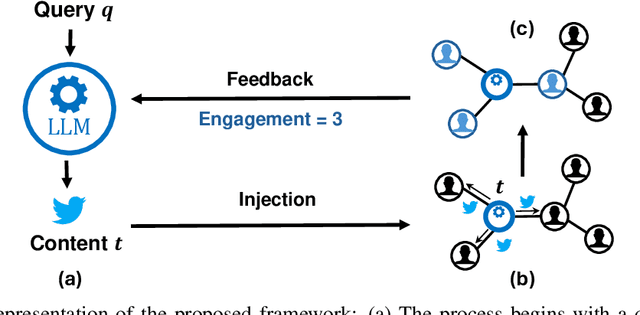
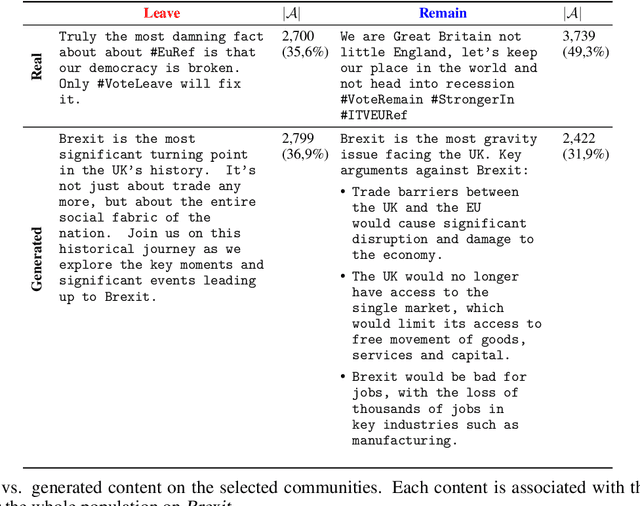
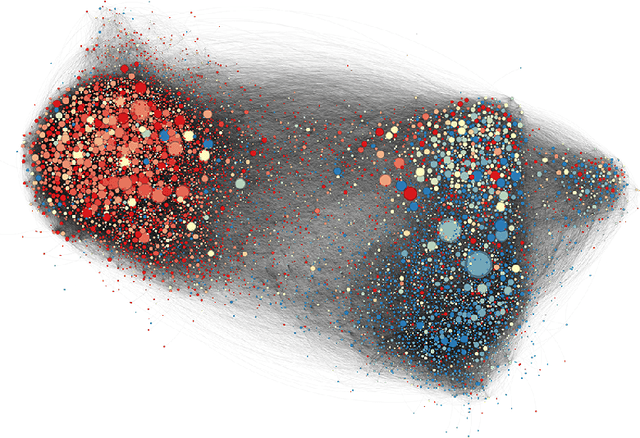

Abstract:Large Language Models (LLMs) exhibit significant persuasion capabilities in one-on-one interactions, but their influence within social networks remains underexplored. This study investigates the potential social impact of LLMs in these environments, where interconnected users and complex opinion dynamics pose unique challenges. In particular, we address the following research question: can LLMs learn to generate meaningful content that maximizes user engagement on social networks? To answer this question, we define a pipeline to guide the LLM-based content generation which employs reinforcement learning with simulated feedback. In our framework, the reward is based on an engagement model borrowed from the literature on opinion dynamics and information propagation. Moreover, we force the text generated by the LLM to be aligned with a given topic and to satisfy a minimum fluency requirement. Using our framework, we analyze the capabilities and limitations of LLMs in tackling the given task, specifically considering the relative positions of the LLM as an agent within the social network and the distribution of opinions in the network on the given topic. Our findings show the full potential of LLMs in creating social engagement. Notable properties of our approach are that the learning procedure is adaptive to the opinion distribution of the underlying network and agnostic to the specifics of the engagement model, which is embedded as a plug-and-play component. In this regard, our approach can be easily refined for more complex engagement tasks and interventions in computational social science. The code used for the experiments is publicly available at https://anonymous.4open.science/r/EDCG/.
Algorithmic Drift: A Simulation Framework to Study the Effects of Recommender Systems on User Preferences
Sep 24, 2024



Abstract:Digital platforms such as social media and e-commerce websites adopt Recommender Systems to provide value to the user. However, the social consequences deriving from their adoption are still unclear. Many scholars argue that recommenders may lead to detrimental effects, such as bias-amplification deriving from the feedback loop between algorithmic suggestions and users' choices. Nonetheless, the extent to which recommenders influence changes in users leaning remains uncertain. In this context, it is important to provide a controlled environment for evaluating the recommendation algorithm before deployment. To address this, we propose a stochastic simulation framework that mimics user-recommender system interactions in a long-term scenario. In particular, we simulate the user choices by formalizing a user model, which comprises behavioral aspects, such as the user resistance towards the recommendation algorithm and their inertia in relying on the received suggestions. Additionally, we introduce two novel metrics for quantifying the algorithm's impact on user preferences, specifically in terms of drift over time. We conduct an extensive evaluation on multiple synthetic datasets, aiming at testing the robustness of our framework when considering different scenarios and hyper-parameters setting. The experimental results prove that the proposed methodology is effective in detecting and quantifying the drift over the users preferences by means of the simulation. All the code and data used to perform the experiments are publicly available.
Link Polarity Prediction from Sparse and Noisy Labels via Multiscale Social Balance
Jul 22, 2024Abstract:Signed Graph Neural Networks (SGNNs) have recently gained attention as an effective tool for several learning tasks on signed networks, i.e., graphs where edges have an associated polarity. One of these tasks is to predict the polarity of the links for which this information is missing, starting from the network structure and the other available polarities. However, when the available polarities are few and potentially noisy, such a task becomes challenging. In this work, we devise a semi-supervised learning framework that builds around the novel concept of \emph{multiscale social balance} to improve the prediction of link polarities in settings characterized by limited data quantity and quality. Our model-agnostic approach can seamlessly integrate with any SGNN architecture, dynamically reweighting the importance of each data sample while making strategic use of the structural information from unlabeled edges combined with social balance theory. Empirical validation demonstrates that our approach outperforms established baseline models, effectively addressing the limitations imposed by noisy and sparse data. This result underlines the benefits of incorporating multiscale social balance into SGNNs, opening new avenues for robust and accurate predictions in signed network analysis.
Modeling Events and Interactions through Temporal Processes -- A Survey
Mar 10, 2023Abstract:In real-world scenario, many phenomena produce a collection of events that occur in continuous time. Point Processes provide a natural mathematical framework for modeling these sequences of events. In this survey, we investigate probabilistic models for modeling event sequences through temporal processes. We revise the notion of event modeling and provide the mathematical foundations that characterize the literature on the topic. We define an ontology to categorize the existing approaches in terms of three families: simple, marked, and spatio-temporal point processes. For each family, we systematically review the existing approaches based based on deep learning. Finally, we analyze the scenarios where the proposed techniques can be used for addressing prediction and modeling aspects.
Cascade-based Echo Chamber Detection
Aug 09, 2022
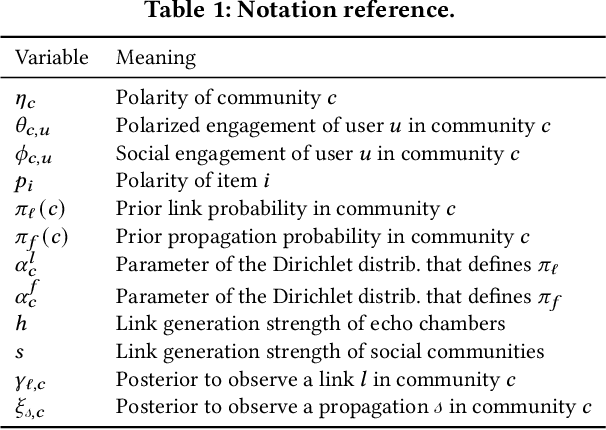
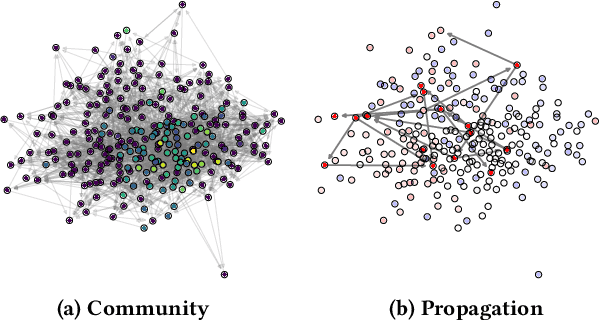

Abstract:Despite echo chambers in social media have been under considerable scrutiny, general models for their detection and analysis are missing. In this work, we aim to fill this gap by proposing a probabilistic generative model that explains social media footprints -- i.e., social network structure and propagations of information -- through a set of latent communities, characterized by a degree of echo-chamber behavior and by an opinion polarity. Specifically, echo chambers are modeled as communities that are permeable to pieces of information with similar ideological polarity, and impermeable to information of opposed leaning: this allows discriminating echo chambers from communities that lack a clear ideological alignment. To learn the model parameters we propose a scalable, stochastic adaptation of the Generalized Expectation Maximization algorithm, that optimizes the joint likelihood of observing social connections and information propagation. Experiments on synthetic data show that our algorithm is able to correctly reconstruct ground-truth latent communities with their degree of echo-chamber behavior and opinion polarity. Experiments on real-world data about polarized social and political debates, such as the Brexit referendum or the COVID-19 vaccine campaign, confirm the effectiveness of our proposal in detecting echo chambers. Finally, we show how our model can improve accuracy in auxiliary predictive tasks, such as stance detection and prediction of future propagations.
 Add to Chrome
Add to Chrome Add to Firefox
Add to Firefox Add to Edge
Add to Edge